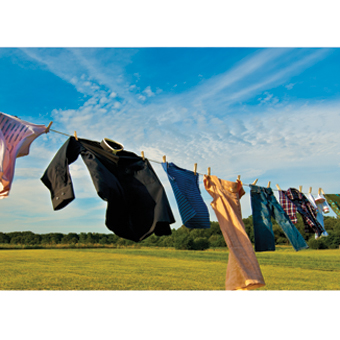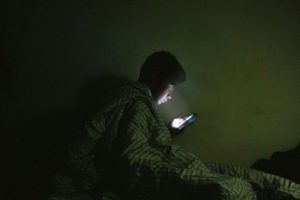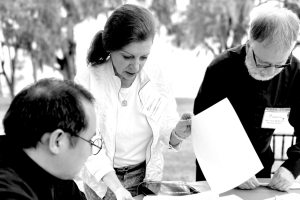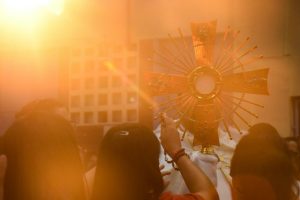Former Episcopal priests are crossing over to the Catholic Church—and bringing their wives and kids along for the ride.
Chuck Hough III was thrilled when his son decided to enter the family business. His concerns were like those of any other parent: He wanted his son to make the decision independently, without pressure from family members or friends. Hough’s business, though, is unlike any other in the country. He and his son, Chuck Hough IV, were recently ordained Catholic priests. Both are serving in Texas. The Houghs will join the 75 or so married former Episcopal priests currently ministering in U.S. Catholic parishes.
The married Catholic priests are being welcomed through a special arrangement called the “Pastoral Provision,” approved in 1980 by Pope John Paul II. Their reasons for converting are diverse.
“I didn’t become Catholic to be a Catholic priest,” says the younger Hough, 31, the newly appointed pastor of Our Lady of Walsingham Catholic Church in Houston. “I became a Catholic for the salvation of my soul and the souls of my children and my wife. It’s a grace from God that they are allowing me to petition to become a priest. It was something that was on my heart, and I would faithfully be a Catholic layman for the rest of my life.”
While preparing for his diaconate ordination, Hough served as an assistant director of religious education at St. Elizabeth Ann Seton Parish in Keller, Texas. Hough and his wife, Lindsay, lived in the parish rectory with their two children, Charlie, 4, and Wills, 1. He taught religious education and coached his son’s soccer team, the Thunderdragons.
The younger Hough renounced his Episcopal orders in June 2011 and, along with his wife, joined the Catholic Church in November. The couple is among a growing faction of Episcopalians who have left the Anglican church, many because of objections to the ordination of women and gay priests as well as changes in the liturgy.
Hough and his dad received their “rescript” from the Congregation of the Doctrine of the Faith in Rome earlier this year. That means they have met all of the spiritual, intellectual, and pastoral requirements for becoming Catholic priests. Together they were ordained deacons in May, with their ordinations to the priesthood following in June. The preparation process involved weeks of study, oral and written exams, and psychological testing.
The elder Hough, 58, served as an Episcopal priest for 31 years until March 2011, when he resigned as the Canon to the Ordinary, a position similar to the vicar general in a Roman Catholic diocese. He was received into the Catholic Church last September.
Crossing the Tiber
Father and son had been working for several years with a group of Episcopal priests in Forth Worth to join the Catholic Church en masse. They even made a presentation to the local Catholic bishop, Kevin Vann, five years ago about unifying the Episcopal and Roman Catholic dioceses.
“We thought the Episcopal Diocese of Fort Worth was the diocese to do this,” says the senior Hough. In the end, he said, several priests got cold feet.
“We were then forced by conscience to resign our livings and take this leap of faith,” he says.
The younger Hough said he wasn’t running away from anything when he made the decision to leave the Episcopal Church. “I was coming toward truth. I can sum up my decision by saying there was a lack of authority [in the Episcopal Church]. We looked, we sounded, and we acted like Catholics, but we weren’t Catholics,” he says.
One of his predecessors in the provision, Father David Bristow, 72, had an entirely different conversion. He made his decision to become Catholic when he was 12 years old. “I knew nothing about the Catholic Church except that it was down the street from our little church and it was big,” says the priest in charge of St. Mary of the Assumption Parish in Fort Worth. Raised by devout Episcopalians, Bristow became intrigued with the Catholic Church by reading books such as Butler’s Lives of the Saints and Faith of Our Fathers by Cardinal James Gibbons.
“I read all of them and one day I got on my bicycle and rode over to the Catholic church, knocked on the door, and said to Father Fox that I wanted to know more about the Catholic Church,” says Bristow. “I became convinced then that the Catholic Church was the church founded by our Lord and therefore it was the true church.”
He already had begun talking to his own rector about becoming an Episcopal priest. His rector told him he believed the two churches would be reconciled by the time Bristow grew up. So Bristow became an Episcopal priest, figuring it would be temporary. He served for 25 years until he left the Episcopal Church in 1995. After 17 months, Bristow received his rescript from Rome. He was ordained a Catholic priest in May 1998.
“I’ve never looked back once and neither has Janice, my wife of 47 years. If we could change anything, we would have come sooner,” he says. The couple has two grown daughters, eight grandchildren, and six great-grandchildren.
Since 1998, Bristow has been assigned to three different parishes in the Fort Worth area. He’s in his 11th year at the historic St. Mary of the Assumption.
At all three churches, he has met parishioners who were uncomfortable about having a married priest. It was more about unfamiliarity, he says. They questioned his spirituality and his commitment to the Roman Catholic Church. After getting to know him and his family, Bristow said his parishioners have been overwhelmingly supportive.
“It was just so new and so different,” he says.
Uncertain welcome
Father Donald Paul Sullins, a married priest and sociologist at Catholic University of America in Washington, has researched the reactions of American Catholics to the married clergy for a book he is writing, Married Catholic Priests (Oxford), to be published next year.
He interviewed nearly all of the Pastoral Provision priests, who said they had been overwhelmingly well received by American Catholics. None had any serious negative reactions to their priesthood. They experienced support, acceptance, and welcoming.
It’s also true that some American Catholics have been open to the ordination of married priests because they believe all priests should be married.
Father David Cooper, pastor of St. Matthias Parish in the Archdiocese of Milwaukee, has been a proponent for an open discussion about a married priesthood.
“We’ve had a married priesthood in the Catholic Church for more than 2,000 years,” he says, referring to the non-Latin rite churches such as the Ukrainian and Maronite Catholic churches. “In the Eastern churches it hasn’t caused much of a problem at all.
“Why is it that the Holy See is able to make exceptions that seem to benefit those who are on the right of theological issues, who are very orthodox and very conservative and very traditional in their outlook, but we can’t seem to get any understanding of the issues for the people on the other side of the spectrum? The Catholic Church is a very big umbrella, and under that umbrella there’s room for just about everybody.”
Sullins’ wife, Patti, says they have seven married ex-Catholic priests in their parish, some of whom are married to former nuns.
When her husband first began his part-time position as an assistant at the parish, “it really stirred up stuff” for some of the parishioners, she allowed.
One stood up at church at the invitation of Sullins and spoke at length about his frustration with the church and its celibacy requirements for priests. They have welcomed Sullins, she says. Still, “They feel cheated. They think it’s time for the church to welcome married priests.”
But that’s not what the Sullinses want.
“It’s a view with which most of us married priests emphatically disagree,” says Sullins. “Since most Pastoral Provision priests are very conservative or orthodox theologically, there is an irony in that the Catholics most likely to celebrate their presence tend to disagree with them about other things, while those who agree with them on church doctrine generally may not celebrate so much the fact that they are married. I was once at a meeting where a group of people in favor of a married priesthood gave me a standing ovation, which embarrassed me because I strongly support the rule of celibacy for priests.”
The married former Episcopal clergy believe their ordinations are an anomaly to the church tradition of celibacy, rather than a new norm.
“I don’t think we are any kind of bellwether for this at all,” says Bristow. “We are exceptions to the rule.”
Before any of the men were ordained Catholic priests, their wives had to agree to go through with it. Like Roman Catholic deacons, the Pastoral Provision priests cannot remarry if they are predeceased by their wives.
“There is a place and a reason for celibacy, as difficult as it may be,” says Father John Lipscomb, spiritual director of the Bethany retreat center in the Diocese of St. Petersburg, Florida, who has been married for more than 40 years. “To be a priest in the Catholic Church today is an overwhelming vocation,” he says, pointing to the larger workload carried by most Catholic priests.
He uses his hospital ministry as an example. As an Episcopal priest, he says, he visited a handful of patients each day instead of the up to 20 that he sees on his twice-weekly assignments helping at a local parish.
“I don’t know if the average Catholic priest could handle a family,” he says, along with so many pastoral obligations. Lipscomb was the bishop of 40,000 Episcopalians in the Southwest Florida Diocese until he retired and left the Episcopal Church in 2007. He and his wife, Marcie, joined St. Timothy’s Parish in North Tampa while he studied for the Catholic priesthood.
Lipscomb, the son of a Baptist minister, says his conversion was more about his personal relationship with Jesus. As a bishop, though, he had publicly disagreed with a number of decisions made by the Episcopal hierarchy, including the election in 2003 of the first openly gay Episcopal bishop. While he opposed some of those moves, Lipscomb said he didn’t see them as church-dividing.
Sullins maintains the church makes a distinction between allowing a married man to be ordained and permitting an ordained man to get married.
“The latter has never been permitted or approved in the history of the church; the former has often been permitted and approved. Eastern rite Catholics often ordain married men today, and there have always been a few married men who have received dispensation to be ordained in the Latin rite,” explains Sullins.
Some of the former Catholic priests who left the church to get married haven’t been supportive of the Pastoral Provision, according to Sullins’ research. Like the former priest who spoke out in his parish, Sullins says, they think it’s unfair they couldn’t remain in the priesthood and be married.
Father and Mrs.
In his research, Sullins also asked married priests how the Catholic Church members have reacted to their wives.
“The priests’ wives are very aware that there is no role or place for them in parishioners’ minds in the Catholic Church, like there was in the Episcopal Church. Most of them handle this graciously and carve out for themselves a place of service. My wife is very musical, so she directs a choir,” says Sullins.
Patti Sullins is the director of liturgy and music at St. Rose of Lima Catholic Church in Baltimore.
As the wife of an Episcopal priest, Patti says she felt a lot of pressure to serve in the parish, host receptions, and to set a good example as a parent. The couple has three children, ages 32, 23, and 15. “It’s like being in a fishbowl; everybody is watching to see how you do this,” she says. “But I liked it.”
In her new role as the wife of a Roman Catholic priest, Patti says her position isn’t so clear.
“Right now, they haven’t figured out what to do with a priest’s wife,” she says. “I’ve had to take it upon myself to get integrated.” One solution, she suggests, would be to incorporate wives into the preparation process, similar to what is required of deacons’ wives.
Lipscomb’s wife, an avid equestrian, had her own public relations business before she retired.
Marilyn Hough, a former Roman Catholic who became Episcopalian, was an assistant principal in public schools for many years and currently operates a jewelry making and craft business. Her daughter-in-law, Lindsay, has a master’s degree in nutrition and already has been recruited by a hospital in Houston.
Marilyn Hough doesn’t mind not having an official position in the parish. She served the traditional role of a priest’s wife in the Episcopal Church and likes being able to nurture her own faith as a returning Roman Catholic without having parish obligations.
“I think the Catholic Church has the right view. I’m the wife and my husband is the priest, and they are wonderful to me. My ministry is to my husband. This has been a very spiritual step back into the Catholic Church for me.”
Job descriptions
Officially, because of the presumed workload, Pastoral Provision priests are not permitted to “have the primary care of the souls” of their congregations by holding the title of pastor, although many of them carry out the same duties. (Father Chuck Hough IV is allowed to serve as pastor of Our Lady of Walsingham because that parish is part of a new, special diocese created for former Anglican priests and congregations.)
Almost all of the married priests celebrate Mass at parishes somewhere while holding full-time jobs in hospitals and schools where they receive the same salaries as laypeople. It’s up to the bishop in each diocese to make sure all of the priests, including the married ones, can make an adequate living.
Bishop Vann of Fort Worth, whose diocese provides health insurance for all of the diocesan priests, including the married priests and their family members, says he looks for bishops who have the willingness and the means to sponsor a married priest before placing Pastoral Provision clergy members. Vann also serves as the pope’s delegate supporting the former Anglicans who become Catholic priests in the United States.
“This is a big leap of faith for most of them—they leave everything behind,” says Vann.
That married priests cost the church more than celibate priests is a myth, says Sullins.
“Even in a parish, although parishes and dioceses often perceive that a married priest costs more to maintain than a celibate one, once you include all the hidden costs of maintaining a rectory, the difference between the two is slim to none,” he says. “Most parishes pay someone to clean, cook, do maintenance on the rectory, mow the lawn, clear the snow, etc., but married priests or their wives usually do all these things themselves. There are some additional benefits costs—health insurance and pensions, for example—but otherwise, married priests do not cost more.” Even the wives who work outside the home, “often contribute substantial, unpaid labor to the parish, which is unacknowledged.”
He said Protestants are used to getting “two-for-one” when they hire a married minister.
According to Sullins, many of the original Pastoral Provision priests agreed to receive the same compensation packages as the celibate priests in their dioceses.
“Every one of them, in my interviews, told me that was more than adequate for their needs, in most cases more commodious than what they had received in the Episcopal Church,” he says.
Bristow, for example, says he and his wife live in their own home and made financial plans for the transition to the Catholic priesthood and their retirement. Some of the older Pastoral Provision priests, including Lipscomb, received their retirement pensions from the Episcopal Church before converting to Catholicism.
Patti Sullins and her husband are owed some retirement benefits from the Episcopal Church and have made their own investments for their future care.
The elder Hough says he, too, prepared for the move financially and physically. At age 58, he doesn’t anticipate being placed in charge of any large congregations. He likely will assist other priests and continue to minister to a small contingent of former Anglicans who have entered the Catholic Church as a group.
Welcome wagon
On January 1, 2012 the Vatican expanded the Pastoral Provision by creating a special nationwide diocese, similar to the Archdiocese for the Military, called an “ordinariate” through which Episcopal priests and their entire congregations can enter the Roman Catholic Church.
So far, the special diocese has seven parishes. One of the most active is in Scranton, Pennsylvania, led by a young Catholic priest who is married with seven children.
Father Eric Bergman, 41, was ordained a Catholic priest in 2007, before the new ordinariate was established.
He was serving as the rector at the Episcopal Church of the Good Shepherd in Scranton when he became averse to what he described as the “theological direction” of the Episcopal Diocese of Bethlehem, Pennsylvania and the national Episcopal Church as a whole. He offered his resignation and invited others with the same concerns to join him in leaving the Anglican Church. About half of the 130 active members did.
Together, they formed the St. Thomas More Society, where Bergman has been serving as chaplain during his conversion and ordination in the Catholic Church. He and his congregation were allowed to worship in a vacant Catholic Church where he celebrates Mass for his now 150 members, using Anglican rites approved by the Roman Catholic Church.
Because his congregation is large enough to support him, his family, and the church operations, the Scranton bishop released Bergman and his members to the ordinariate. They are planning to buy property for their own parish and open a school under the direction of Father Jeffrey Steenson, the Ordinary of the Personal Ordinariate of the Chair of St. Peter, who is a married, former Episcopal priest ordained for the Roman Catholic Archdiocese of Santa Fe, New Mexico in 2009.
The Chair of St. Peter is based at St. Mary’s Seminary in Houston. Bergman’s congregation will preserve the Anglican traditions, like the strong emphasis on sacred music, and his school will teach Roman Catholic doctrine while maintaining some of the celebrated heritage of the Episcopal Church such as music, structure, and some of its prayers. The parishes will use the Book of Divine Worship and the Roman Missal.
“We share the same faith, we simply express it in a different way,” says Bergman, who, as part of the ordinariate, will always be assigned to parishes like St. Thomas More where the Anglican traditions are maintained.
Church leaders estimate about 1,400 individuals make up the congregations contemplating the move to the Roman Catholic Church through the new process.
Bristow hosted the diaconate ordinations in May of the Houghs at St. Mary of the Assumption Church.
Watching her husband and son being ordained side-by-side was one of the most rewarding moments of her life, says Marilyn Hough.
“When I was young and had a new baby, a bishop’s wife told me to first take care of my husband and then my family, and the church will fall in line,” she says. “She was right—it did.”
This article appeared in the August 2012 issue of U.S. Catholic (Vol. 77, No. 8, pages 12-17).
Image: Tom Wright













Add comment